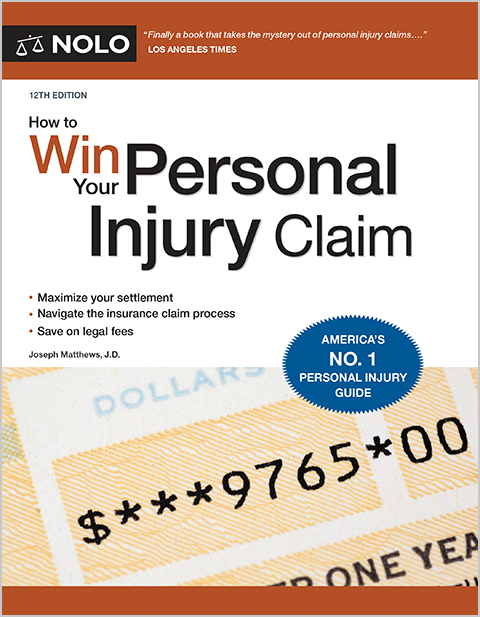Learn about the laws that set a strict filing deadline on your right to file a personal injury lawsuit.
If you think you might have a personal injury case after any kind of accident or injury, it's crucial to pay attention to the statute of limitations. This is a law that sets a strict limit on how much time can pass between your injury and the filing of any lawsuit against whoever was at fault. Let's take a closer look at these laws, and why it's so important to make sure you comply with them.
- What Is a Statute of Limitations?
- What Happens If You Miss the Statute of Limitations Deadline?
- Does the Statute of Limitations Apply to Insurance Claims?
- What's the Standard Statute of Limitations in Personal Injury Cases?
- When Does the Statute of Limitations "Clock" Start Running?
- Can the Personal Injury Statute of Limitations Be Extended?
- Getting Help With a Personal Injury Case
What Is a Statute of Limitations?
A statute of limitations is a law that sets a strict time limit on your right to file a lawsuit in court. All states have passed statutes of limitations for the filing of different kinds of lawsuits in the state's civil court system. Most states have a statute of limitations that specifically applies to personal injury cases (or to lawsuits alleging "negligence," which is the legal fault theory under which most personal injury lawsuits are brought).
What Happens If You Miss the Statute of Limitations Deadline?
Whatever statute of limitations applies to your potential case, if the deadline has passed and you try to file a lawsuit anyway, the court is sure to dismiss your case, and you'll have lost any chance to get court-ordered compensation for your injuries and related losses. It won't matter how badly you were hurt, or how clear it is that the person you're trying to sue is to blame for what happened.
A few rare situations can effectively extend the filing deadline, and we'll cover those later on.
Does the Statute of Limitations Apply to Insurance Claims?
No, the deadline only applies to the filing of a court case. But even during the insurance claim process, insurance adjusters keep their eye on the statute of limitations lawsuit-filing deadline, and so should you. Even if you don't plan on filing a lawsuit after an accident, it's important to understand the statute of limitations in your state, and how it applies to your situation. It's crucial to leave yourself plenty of time to take things to court, or at least have that option in your back pocket as a bargaining chip during personal injury settlement negotiations.
Let's say your car insurance claim drags on for years after your car accident. You live in a state with a two-year statute of limitations for injury lawsuits. If settlement talks are still ongoing when the two-year deadline passes, and you haven't filed your lawsuit in court as a way of preserving your rights, you've lost all your negotiation leverage. Now, the insurance company knows you can either accept a low settlement offer, or get nothing.
What's the Standard Statute of Limitations in Personal Injury Cases?
The statute of limitations in personal injury cases ranges from as short as one year to as long as six years, depending on the law in a given state. For details on the law where you live, check the statute of limitations and other personal injury laws in your state.
When Does the Statute of Limitations "Clock" Start Running?
In most personal injury cases, the statute of limitations "clock" begins running on the day you were injured. For example, in a car accident case, the start date is the day on which the crash occurred. Every day counts, including weekends and holidays. But something called the "discovery rule" might come into play when it comes to the starting of the statute of limitations clock in personal injury cases.
The "Discovery Rule" and the Statute of Limitations
Most states have some form of a "discovery rule" exception to the standard statute of limitations deadline in an injury case. In general, the discovery rule extends the filing deadline in situations where the injured person did not know (and had no reasonable basis for knowing) right away that:
- they suffered an injury, and/or
- that the potential defendant's actions may have caused the injury.
In most states, if the discovery rule applies, the statute of limitations clock won't start running until the person knows (or should have realized, in the eyes of the law), that they were injured, and that someone else might be to blame.
This situation isn't as uncommon as you might think.
Example of the Discovery Rule in a Personal Injury Case
Let's say your state has a two-year statute of limitations for personal injury cases, but that your state has a discovery rule that says that the statute of limitations doesn't begin running in a personal injury case until the date the plaintiff: 1) knew or had sufficient notice that he/she was injured; and 2) knew or had sufficient notice of the cause of the harm.
Let's say you develop mesothelioma, a form of lung cancer that comes from exposure to asbestos. Your doctor asks you if you have any asbestos in your house, and you say no, since you have no reason to believe otherwise. Two years later, renovation reveals that the pipes in your basement have asbestos insulation, and that the insulation has been exposed and airborne the entire time you've been living in the house.
If the statute of limitations deadline has passed, your lawyer might argue that ongoing exposure equals an ongoing injury. But you might also rely on the discovery rule in this situation. Your argument would be that the statute of limitations "clock" didn't begin running on the day of your cancer diagnosis, but on the day you discovered that you've been living with asbestos in your house all these years.
Relying on the "discovery" rule isn't an option in many kinds of personal injury cases (those stemming from car accidents or dog bites, for example). But in addition to the asbestos example we just discussed, the rule might legitimately come into play in medical malpractice lawsuits and product liability cases (involving defective and dangerous products).
Can the Personal Injury Statute of Limitations Be Extended?
Besides the discovery rule we just discussed, in most states there are several other ways the statute of limitations might be extended.
If the Defendant Leaves the State
If the person you're trying to sue left the state for any period of time after causing the accident that led to your injury, in most states, the statute of limitations "clock" will pause for the period of their absence. So, if the statute of limitations time window for filing a personal injury lawsuit is three years, and the defendant was outside the state for a year after the accident, the statute of limitations in your case would be extended by another year.
If the Injured Person Is a Minor or Under a Legal Disability
Special lawsuit-filing rules usually also apply if the plaintiff is a minor, or is subject to some kind of mental disability. In California, for example, the statute of limitations clock will be paused if the injured person was under the age of 18 or was "lacking the legal capacity to make decisions" (i.e. subject to a temporary or permanent mental illness) at the time of the underlying accident.
Getting Help With a Personal Injury Case
After any kind of accident, it's important to understand how the statute of limitations applies to any lawsuit you might end up filing. When your injuries are significant and it looks like the insurance company or the at-fault party won't come to the table with a fair settlement offer, the statute of limitations deadline becomes crucial.
To protect your rights and your options, it might make sense to discuss your situation with an experienced attorney. Learn more about finding the right personal injury lawyer for you and your case, and how personal injury lawyers get paid.
- What Is a Statute of Limitations?
- What Happens If You Miss the Statute of Limitations Deadline?
- Does the Statute of Limitations Apply to Insurance Claims?
- What's the Standard Statute of Limitations in Personal Injury Cases?
- When Does the Statute of Limitations "Clock" Start Running?
- Can the Personal Injury Statute of Limitations Be Extended?
- Getting Help With a Personal Injury Case


